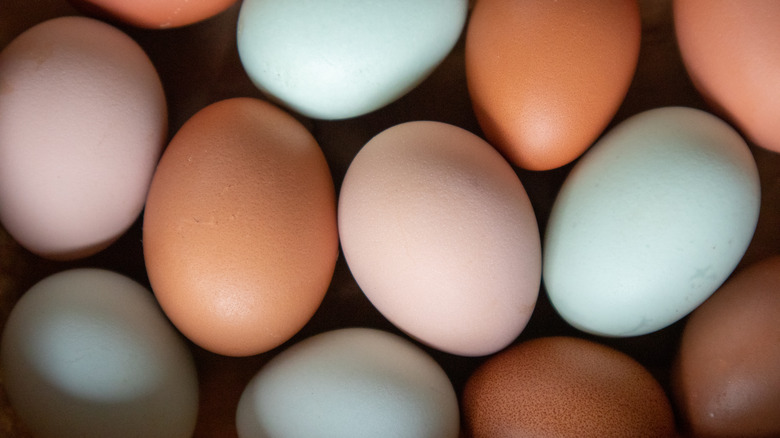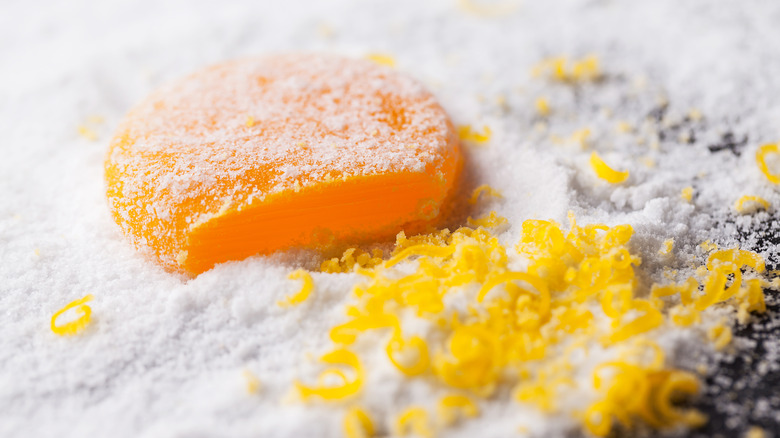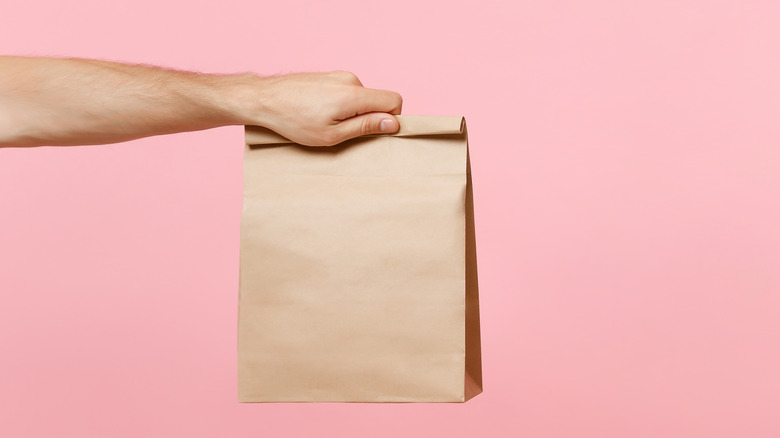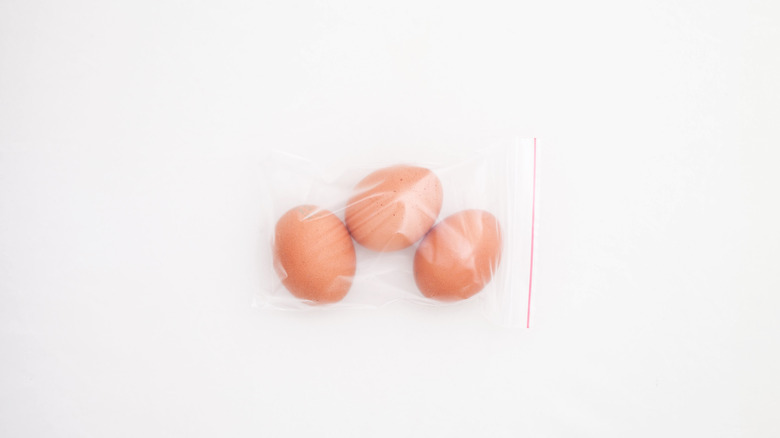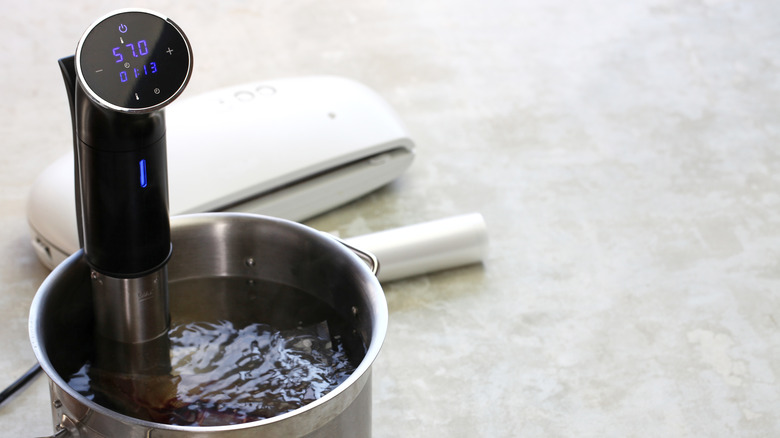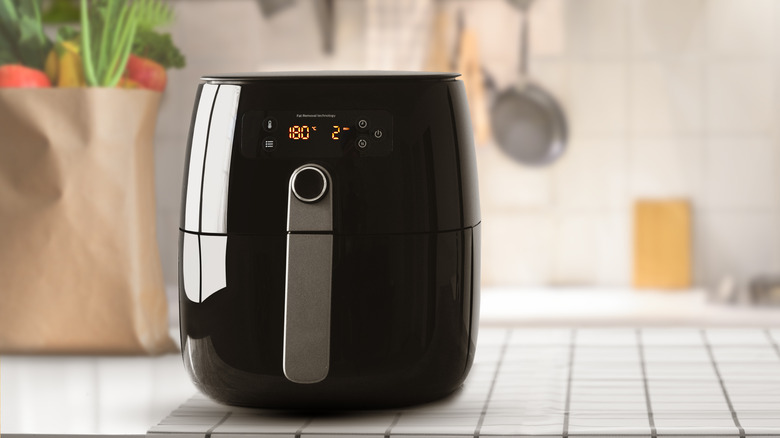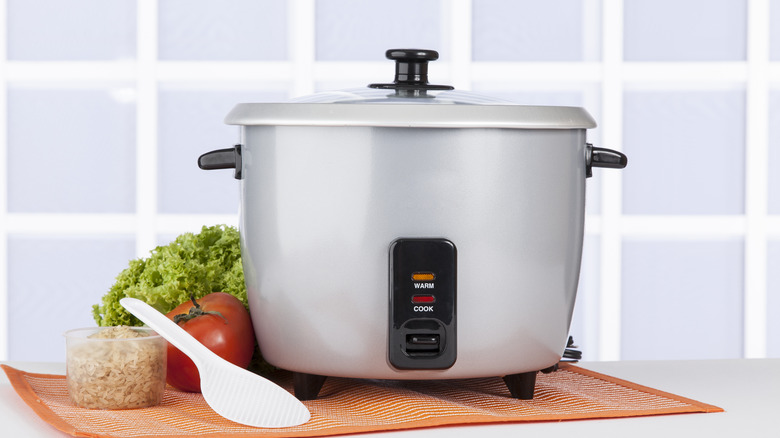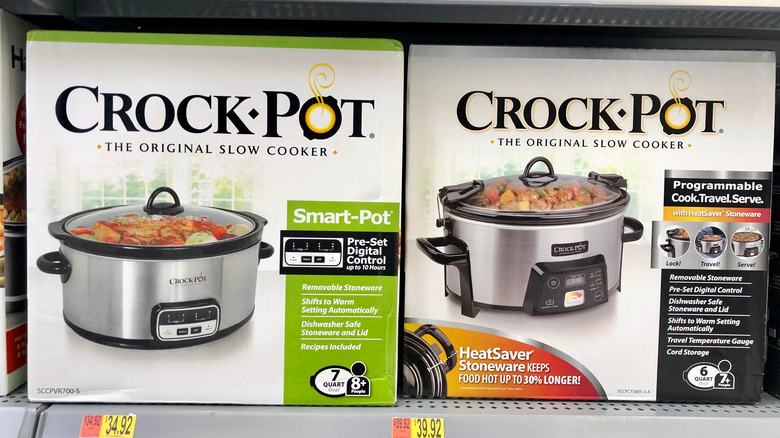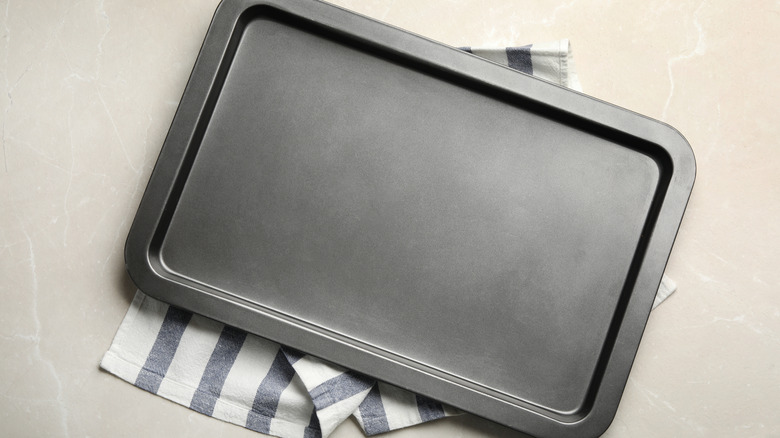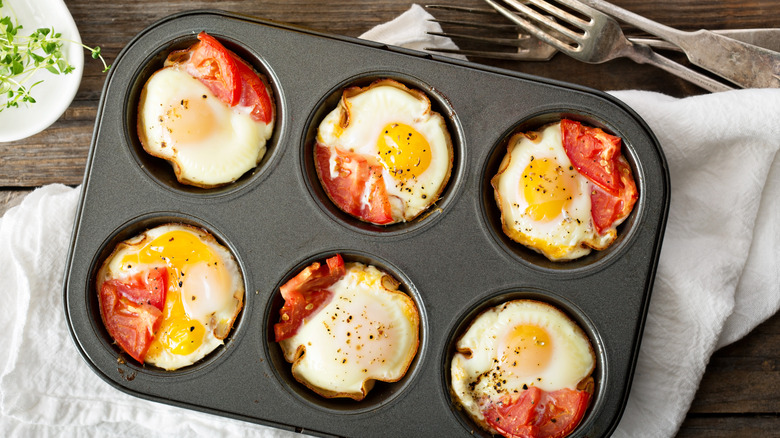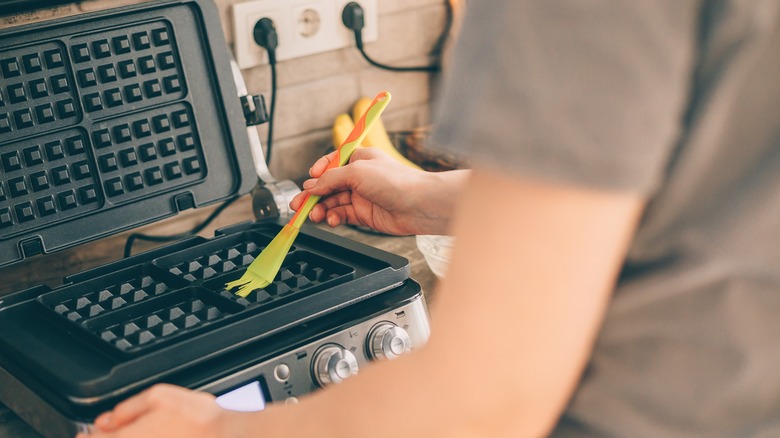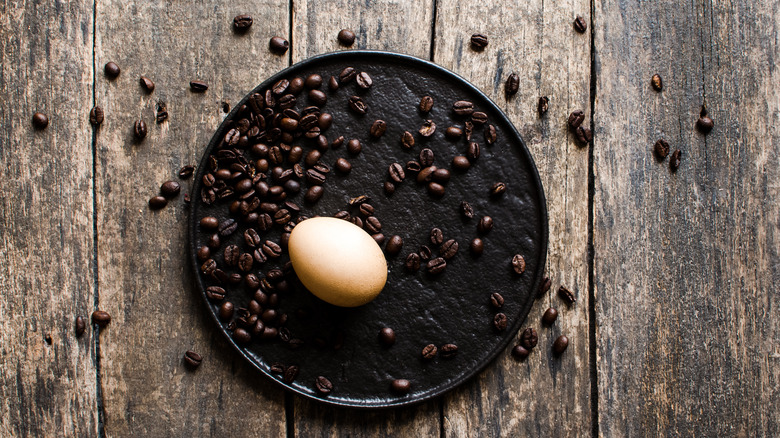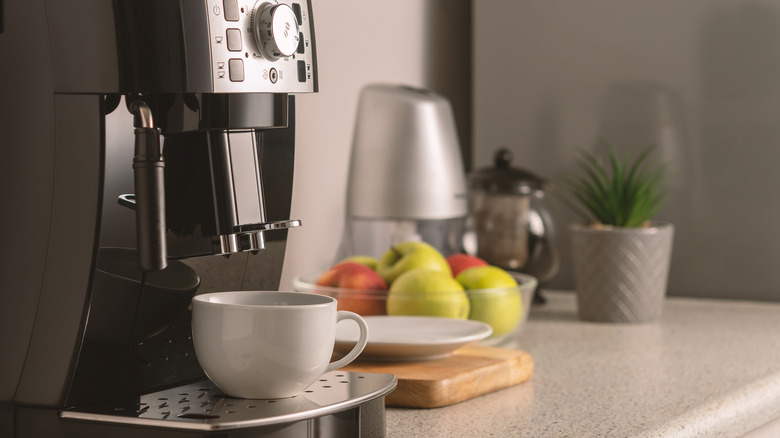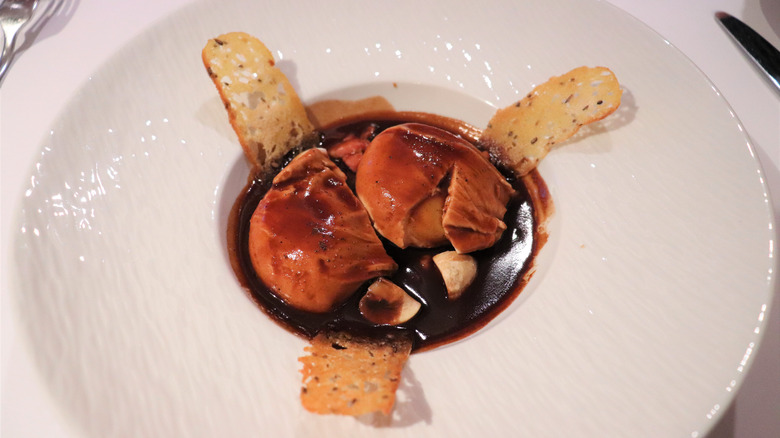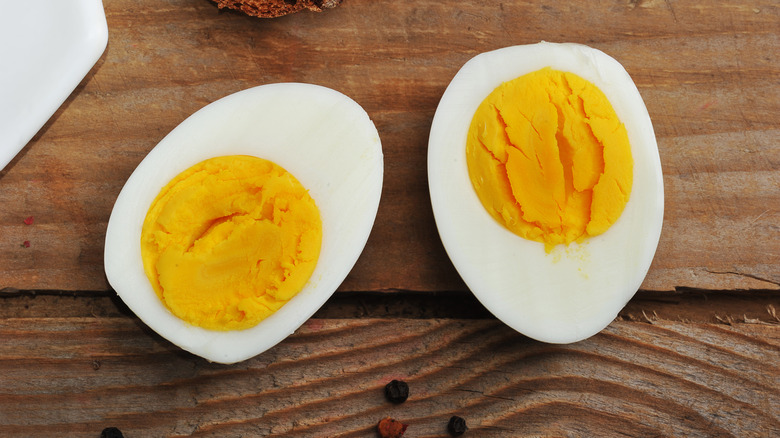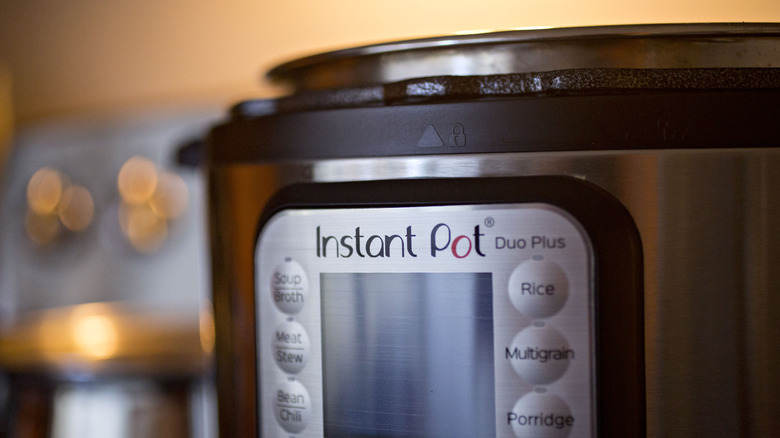The 15 Most Unique Ways To Cook Eggs
Scrambled. Fried. Poached. Boiled. You think you know eggs and all the ways to cook them. Scrambled? Mix them with some water or milk and gently move them around a nonstick pan until you reach creamy curd perfection. Fried? Throw some oil in a pan, crack the egg on top, and flip at the perfect moment to achieve the yolky consistency of your dreams. Boiling? Well, you get the idea.
The point is, there are lots of ways to cook eggs and most of them are pretty standard, rookie stuff, particularly for a home cook that's been around the block a few times. Some methods might even be a little boring. If your eggs are starting to feel more blah than brilliantly breakfast-worthy, it might not be the eggs' fault. You may just need to try one of these unique ways to cook your eggs. Some of these unique methods are brilliant hacks, while others are just plain interesting, but all are sure to liven up your breakfast table.
Curing
Cured eggs are quite often used as a garnish, and for good reason. Cured eggs offer a condensed version of the flavor profile of a typical egg, with a saltier umami kick for a complementary burst of deliciousness. Because this cooking method packs so much flavor into each and every tiny yolk, though, you might not want to eat as many cured eggs as scrambled eggs. You may even prefer to grate your cured eggs over your dish, rather than using them whole.
As MasterClass explains, the curing process for eggs is by no means a quick one. You'll need a few days' time. You have to strain your egg yolks free from the egg white, then bury the eggs in salt, before letting them cure in the fridge for several days. After that, you dehydrate the eggs in either a dehydrator or an oven. Once cured, the egg yolks can be added to salads, pasta, and soups, and are often used in place of other savory, umami-filled ingredients, such as cheese, or just in place of plain salt.
In a paper bag
Who needs a nonstick pan when you have a paper bag? Of our unique ways to cook your next batch of eggs this may not be the most practical, but it is a smart hack for when you're cooking over a campfire. No campfire? You could feasibly do this with any open flame or coals.
As Southern Living explains, this cooking method does require one other ingredient: bacon, and the thicker, the better. What you do is, layer your bag with the bacon, being sure that the bacon creeps up the side of the bag. This creates a protective layer between the eggs and the paper, so your eggs don't end up soaking through and onto the ground, and so that the bag doesn't burn.
Once the eggs are deposited on top of your layer of bacon, you roll the top of the bag closed, sealing everything inside. Then, you'll need to suspend the paper bag over your low fire or hot coals somehow. Southern Living's example uses a stick, but if you're not roughing it, you could easily use a pair of tongs. Remember to move the bag around on occasion, to get an even cook. After about five to seven minutes, both the bacon and the eggs should be done, though times will vary based on the heat of your fire.
In a Ziploc bag
While cooking eggs in a paper bag might be a fun campground trick, cooking your eggs in a Ziploc or similar plastic bag is a trick that requires no trip out into the great outdoors. The method recently went viral on TikTok, as In the Know reported, with a video featuring user Kyle Istook cracking some eggs into a bag, before adding other typical omelet ingredients. He then adds the bag to boiling water. After a few minutes, the bag comes up and an omelet slides out.
Of course, while some liken this cooking method to sous vide, which is a slow-cooking method that cooks packages of food submerged in hot water, it's worth noting that sous vide doesn't use boiling water. In fact, this omelet hack has been called dangerous because boiling water can melt or soften many plastic bags, while other plastic bags, if they don't soften or melt under high temperatures, might at the very least leak dangerous chemicals into your food.
The verdict? If you plan to cook your eggs in a Ziploc bag, TikTok-style, do so at your own risk.
Sous vide
If you absolutely do want to cook your eggs in a bag in hot water, but you recognize that cooking a Ziploc bag full of eggs in boiling water comes with its risks, try traditional sous vide. As smart home kitchen appliance brand Saki explains, you can easily sous vide an egg to achieve a similar texture to what you might get when poaching an egg — which is great news if you've never quite been able to master this particularly tricky egg-cooking method.
Essentially, poaching eggs in a sous vide cooker is the same as poaching eggs on the stovetop, but without all the babysitting that you would normally need to do. All you do is heat your sous vide water to the appropriate temperature, drop in your eggs, set a timer, and then come back when the time is up to remove the eggs. From there, you do have to either run the eggs under cold water or dip them in an ice bath, to ensure they don't continue cooking from the residual heat, but, otherwise, that's pretty much it.
Air frying
You can use your air fryer for just about everything. As creative home cooks can attest, the small countertop appliance does so much more than just "fry." Believe it or not, you can also cook eggs in your air fryer, as Real Simple shows, explaining the cooking method that comes from a viral video from TikTok user KortneyandKarlee.
No, you won't be cracking your eggs into your fryer basket for this method (that would just be messy and gross). Instead, place whole eggs in your fryer basket for 15 minutes, setting the air fryer to 270 degrees Fahrenheit. After 15 minutes, remove the eggs and place them into an ice bath so they won't continue cooking, until they cool. The result is a boiled egg without the need to actually boil any water.
Unfortunately, while you save on the mess, the 15 minutes required to air fry the egg is longer than it would take to actually boil an egg. Several commenters on the original TikTok video pointed this out, though they overlook the fact that this saves water.
In a rice cooker
Tiger recommends its rice cookers for cooking hard-boiled eggs. Unlike when you cook "boiled" eggs in an air fryer, which just requires you to plop your eggs in the fryer basket, wait 15 minutes, and then remove the eggs, cooking your hard-boiled eggs in a rice cooker is more akin to the traditional method, as you do still have to cover the eggs in water. After this first step, Tiger says to set the rice cooker to "slow cook" and then let the eggs cook for 10 minutes before rinsing and peeling.
If you only have a rice cooker on hand, you're not stuck only making "boiled" eggs. You can also scramble eggs in a rice cooker. Just mix your eggs with the liquid and seasonings of your choice, add a little oil to the bottom of your rice cooker, and then cook the eggs on a warm setting. Just like you would when scrambling eggs on the stovetop, you'll need to give the eggs a stir every once in a while, but the end result is the same.
Slow cooking
Southern Living recommends cooking your eggs in a slow cooker if you have extra time, and also need to cook a larger quantity of eggs than you normally might. This method can cook lots of eggs at once, but it is, of course, on the slower side.
The cooking process is very similar to scrambling eggs any other way. You just grease the inside of your slow cooker and then add in the scrambled egg mixture, before setting the cooker to low, covering it up, and waiting for the eggs to cook. This may take a few hours from start to finish, but do note that you can't completely "set it and forget it." You will have to stir the eggs every once in a while (about twice an hour, according to Southern Living), if you want to end up with scrambled egg curds versus just a block of cooked eggs.
On a sheet pan
To cook fried eggs or sunny-side-up eggs for a crowd, there's hardly any easier way to cook your eggs than on a sheet pan. No crowd? That's fine. This method also works well if you're meal-prepping and need to cook a lot of eggs at one time.
The process is simple, as Food Network explains. All you need to do is grease a large sheet pan, preheat it in your oven for a few minutes, and then pour on your cracked eggs. Then, return the sheet pan to the oven and bake the eggs until they reach your desired doneness. While you'll definitely want to cook the eggs until the whites are set and cooked through, you can play around a little bit more with the yolks. Take the eggs from the oven as soon as the whites set for a runnier, sunny-side-up-style yolk. Let the eggs cook longer to get more of an over-medium or fried texture.
In a muffin tin
You may know that you can make mini quiches in your muffin tins, but did you know that you can also poach eggs in a muffin tin? If you're not quite craving quiche and, instead, would love a runny poached egg to top your English muffin, break out the muffin tin and try this method from Southern Living.
The publication tested the method out by placing one cracked egg and one tablespoon of water in each muffin tin space, then placing the tin in the oven for just over 10 minutes at 350 degrees Fahrenheit. From there, they let the eggs sit for a few additional minutes, to continue cooking via the residual heat from the oven.
The result? The writer reported that the muffin tin-poached eggs, while not as fluffy as your typical poached egg, were still deliciously runny, with the desired texture of a poached egg. Plus, thanks to the muffin tin, each egg was exactly the same shape and size, which can be a real help if you're plating up multiple breakfasts at once, making something like benedicts or breakfast sandwiches.
In a waffle maker
If you're only using your waffle maker for waffles, you're missing out. This handy little appliance can do so much more, including cooking eggs. According to Clean Eating, cooking eggs with your waffle maker is a little like a cross between cooking an omelet on a griddle and cooking a frittata, since the waffle maker cooks from both sides. However you describe the end result, though, it's delicious.
To make eggs on your waffle maker, all you need to do is mix your eggs just like you would when making an egg scramble with extra ingredients, such as diced ham, onions, peppers, or cheese. Then, grease the waffle maker, pour on the egg mixture, and close the waffle maker, as you would when making a waffle. Let the waffle maker do its thing for just a minute (literally, just a minute), and then open it up to find cooked eggs with all your favorite mix-ins.
In your coffee
You may have heard the (incorrect, as this Lifehacker video shows) "tip" that you can soft boil an egg in your morning coffee. Just drop the egg into your coffee and let it sit, and come back in a few minutes to an egg cooked by the coffee's hot temperature. Unfortunately, this doesn't actually work, as the coffee's temperature isn't sustained long enough after it goes from pot to cup to cook the egg (and who wants all those eggshell germs in their coffee, anyway?), but there is a way to combine eggs and coffee for a tasty, if unconventional, breakfast treat.
Swedish egg coffee, also sometimes called church basement coffee, as America's Test Kitchen describes, was brought to the Midwest by immigrants from Sweden, Norway, and Denmark. The coffee is made by mixing a raw egg, including the broken shells, with coffee grounds. After boiling this mixture in water, you have a milder cup of coffee than normal, thanks to the eggshells, which reduce the coffee's acidity. The raw egg, which attaches to the grounds, ensures they stay together in a mass that you can remove from the coffee when it's done.
In an espresso machine
While an espresso machine might not be as common a household countertop appliance as a rice cooker or a slow cooker, if you have one handy, you can use it to cook your eggs in this neat trick, according to Well + Good. The resulting eggs, the publication notes, are steamed (a type of egg cooking that's normally done on the stovetop in a double boiler), with a super-soft texture that's still slightly runny.
To steam eggs in an espresso machine, all you have to do is whisk your eggs like you would if you intended to scramble them. Then, just use your machine's steaming wand at full power to cook the eggs (once any residual water has been removed from the steamer; you don't want that added to your egg mixture). With the wand in the eggs, gently move the eggs around, just like you might when scrambling, until done. The whole process takes less than a minute.
In your wine
Want an impressive and vibrantly hued addition to your brunch table? Poach your eggs in wine. Once you've mastered the art of poaching eggs, you can level up this delicious and delicate egg-cooking method with the addition of your favorite house red.
According to MasterClass, poaching eggs in wine colors the eggs maroon, but it does more than just switch up your breakfast's appearance. The cooking method also imbues the eggs with the wine's various flavor notes, while also doing the same for the wine. For this reason, MasterClass says, you can poach your eggs in wine once, and then use that same wine for poaching multiple items over the course of a week, if you keep the wine refrigerated between uses.
Eggs poached in wine go particularly well with savory foods beyond the breakfast table, such as sauteed vegetables, or you can serve them, as the New York Times suggests, with cheese, bread, and a sprinkling of herbs.
Bruleed
Sure, you know about the classic creme brulee, but what if you start brulee-ing other items around your kitchen — such as your hard-boiled eggs? As WonderHowTo explains, you can brulee your eggs by splitting your hard-boiled eggs after they've finished cooking and cooling. Then, add some salt and sugar to the cut side of each egg. Finally, take your kitchen torch to the sugar and there you have it: hard-boiled egg brulee. You get the savory flavor of the egg, along with that burnt sugar, caramelized flavor of any bruleed item, for a unique breakfast addition that's sure to impress.
Of course, you can also enjoy hard-boiled eggs for dessert if you decide to go the route of this method that that will change your hard-boiled eggs forever. However you indulge in this more luxurious take on the classic hard-boiled egg, you have Los Angeles Chef Alvin Cailan to thank for the invention, as he popularized the concept after his experiment giving eggs a sweet twist proved successful.
In an Instant Pot
There are many ways to boil an egg, including in your Instant Pot. Your Instant Pot is a great tool to use for boiling large quantities of eggs, as you don't need to adjust your cooking time or method to account for more eggs being cooked, and you can fit quite a few eggs into an Instant Pot's inner chamber. However, Pressure Cooking Today does note that you might have to play with the cooking time depending on your altitude — just like you might have to change your Instant Pot timing based on altitude when cooking most foods.
In addition to adding eggs to your Instant Pot and boiling them in water via your Instant Pot's pressure cooker setting, Pressure Cooking Today also says that you can pressure cook soft-boiled eggs, poached eggs, or an egg loaf, aka one big circular "loaf" of eggs that you cut as desired, though some of these methods do require extra Instant Pot accessories. For the standard hard-boiled eggs, though, no accessories are needed; as Food Network explains, just set your eggs on the Instant Pot trivet, add water, and pressure cook before adding the eggs to an ice bath.
